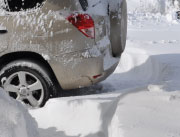The Cold War


BE PREPARED When it comes to blizzard preparedness the big question is how your city lays the groundwork — literally. While the US spreads an average of 137 pounds of salt per person on its thoroughfares each year environmentalists are concerned about the effects of all this salt on rivers sea life and plants. Others have turned to more creative solutions including Wisconsin’s own dairy blend: mixing the salt with cheese brine
On a Tuesday afternoon in January 2014 light snow began to fall over Atlanta Georgia. Anticipating severe weather thousands of people in downtown Atlanta left work early and headed toward the highway hoping to make it home to the suburbs before things got worse. The public school system announced that students would be dismissed early. By late afternoon Interstate 285 was a gridlock of tractor-trailers abandoned cars and commuters grouped on the roadsides hoping to pass the time more quickly by socializing with their fellow stranded Southerners. For many a quick ten-mile drive had turned into a harrowing six-hour ordeal while others were stuck on the highway without food gas or heat for more than 20 hours. Thousands of children remained stranded in schools overnight and didn’t make it home until the next day after the National Guard intervened.
So how much snow fell over Atlanta during what became known as the Snow Jam of 2014?
Just two and a half measly inches.
If it snows once a decade in southern Georgia that’s considered a winter wonder. People have no chains or snow tires the municipality has no snow plows and so the city just shuts down while residents stay home and drink hot chocolate until the sun comes out and melts it all away.
But contrast those rare Southern flurries with the piles of snow that blanket some cities each winter. In places like Chicago Montreal or Moscow snow is rarely an excuse to close schools and the city runs like clockwork even during the most inclement weather. How do these snowy cities stay one step ahead of the weather and keep the cars and buses rolling the shelves stocked and maintain business as usual? Some have implemented their own unique solutions for battling the extreme cold and excessive snowfall.
Say Cheese in Milwaukee
Average Snowfall: 52.4 inches
Challenge: How to maintain budgetary and environmentally friendly snow preparedness
Solution: Cheese brine
Wisconsin is known as the dairy capital of the United States so it comes as no surprise that folks in rural Polk County have put their dairy farms to good use and hit upon a solution to the high costs and environmental hazards associated with salting roads. According to the New York Times a study conducted in the county in 2009 found that mixing salt with liquid cheese brine from local dairy farms resulted in a 30 to 40 percent decrease in road salt use.

While you might not be able to fathom living in any city colder than Moscow or Montreal scientists on research grants off the coast of Antarctica aren’t the only ones who choose to live in places so cold your saliva ices over and your glasses freeze onto your face
In 2013 Milwaukee decided to join the cheese craze. After failed attempts to cut salting costs by mixing salt with a molasses-type product or spraying the rock salt with sugar beet juice to make it last longer (residents complained that the molasses left shoe prints on their floors and the beet juice mixture clogged truck engines) the city decided to take advantage of the local cuisine.
When local dairies produce cheese they’re forced to deal with pounds of excess brine that’s generally carted off as waste. Milwaukee and other neighboring municipalities however were happy to haul away the salty cheese brine. Aside from reducing the amount of rock salt usage cheese brine freezes at lower temperatures than plain salt brine. Residents say they haven’t noticed any difference in the smell of their streets — you’d have to get down on the pavement to get a whiff of curd
Oops! We could not locate your form.







